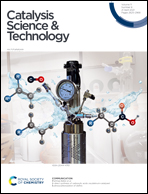Interfacial biocatalysis in bacteria-stabilized Pickering emulsions for microbial transformation of hydrophobic chemicals†
Abstract
Microbial transformation or degradation of hydrophobic substrates is usually hindered by their limited aqueous solubilities. Pickering interfacial catalysis in biphasic systems has recently been developed to enhance catalytic efficiency. Till now, catalytically active microorganisms have been rarely exploited as Pickering emulsifiers. Here, whole-cell-based Pickering interfacial biocatalysis was implemented by using Mycobacterium neoaurum whole cells as robust emulsifiers and self-replicating biocatalysts. The biocatalysis was exemplified by microbial transformation of hydrophobic cholesterol into androst-4-ene-3,17-dione (AD) and androst-1,4-diene-3,17-dione (ADD). We found that Pickering emulsions with different oil types were stabilized solely by the hydrophobic bacteria. Meanwhile, the effective adsorption of the bacteria at the Pickering interfaces dramatically enhanced their biocatalytic activities, demonstrating that Pickering interfacial biocatalysis was a new mechanism for bacteria to utilize hydrophobic substrates. By varying key parameters, it was also shown that the biocatalytic activity was closely correlated with the Pickering emulsion structure. Furthermore, the efficient fermentation of cholesterol in the Pickering emulsion was firstly realized with rapid cell growth and high AD(D) productivity, revealing that the oil–water interface of Pickering emulsions was an exceptional habitat for bacteria to simultaneously utilize hydrophobic and hydrophilic chemicals. This study will offer a new strategy for effective microbial transformation of hydrophobic substrates.

- This article is part of the themed collection: Biocatalysis: A cross-journal collection


 Please wait while we load your content...
Please wait while we load your content...